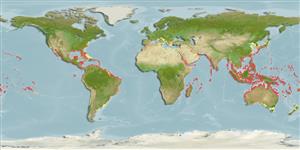Common names from other countries
Classification / Names / Names
Namen | Synonyme | Catalog of Fishes (gen., sp.) | ITIS | CoL | WoRMS
Environment: milieu / climate zone / depth range / distribution range
Ökologie
; tiefenbereich 0 - 25 m (Ref. 83908). Tropical
Indo-Pacific, Atlantic Ocean and the Mediterranean.
Length at first maturity / Size / Gewicht / Alter
Maturity: Lm ? range ? - ? cm
Thalli form greenish to cream amorphous clumps, attached by rhizoids at various points where segments get in contact with the substrate. Branches composed of moderately calcified flat segments with a distinct central rib, generally reniform to flabellate with the upper margin entire, sinuate to deeply lobed, 3 to 8 mm high, 4 to 10 mm wide, and 0.5 to 7 mm thick. Cortex consisting of 5 layers of utricles formed by repeated dichotomies from the medullary filaments; outermost utricles adhere slightly after decalcification, hexagonal in surface view, 23 by 40 to 50 μm in transverse section; secondary utricles about 17 μm wide. Central medullary filaments extend along the segments, terete and trichotomously branched, with evident constrictions at a short distance above the point of branching. Amorphous clumps up to 15 cm in diameter (Ref. 80758).
Not utilized commercially, although found to be a source of growth regulators such as auxin, gibberellin, cytokinin; has antibacterial and antifungal properties (Ref. 80758). Grows in the lower intertidal zone of coral reefs or on dead corals below the low-tide mark in calm shallow waters (Ref. 80758).
Guiry, M.D. and G.M. Guiry. 2009. (Ref. 80701)
IUCN Rote Liste Status (Ref. 130435)
CITES Status (Ref. 108899)
Not Evaluated
Not Evaluated
Nutzung durch Menschen
| FishSource |
Tools
Mehr Information
NamenSynonymeRäuberFortpflanzungGeschlechtsreifeAblaichenFecundityEierEientwicklung
Alter/GrößeWachstumLänge-GewichtLänge-LängeMorphologieLarvenDichte
Internet Quellen
Estimates based on models
Preferred temperature
(Ref.
115969): 24.6 - 29.2, mean 28 (based on 4250 cells).
